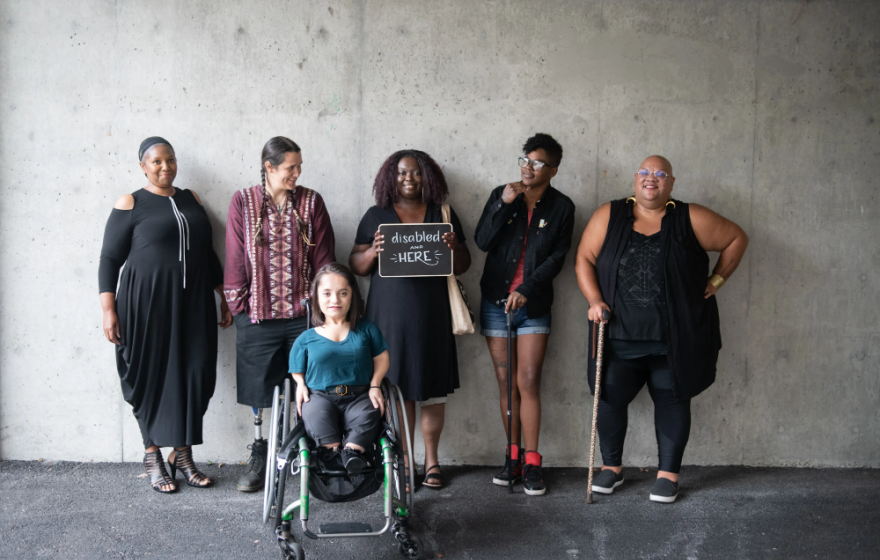Ableism and Disablism are forms of discrimination against people with disabilities, which can happen on individual and societal levels. Disabled people often face discrimination, which can be based on harmful beliefs and attitudes. According to the Ontario Human Rights Commission (OHRC), “disability continues to be the most often cited ground of discrimination under the Code in human rights claims made to the Human Rights Tribunal of Ontario (HRTO)” (OHRC, 2018).
Ableism
Ableism is harmful and can lead to oppression. It is not simply about using certain words but that language becomes a tool of oppression (Brown, 2016). Ableism is when people with privilege disregard their privilege and deny the harm caused to disabled people (Palacsio, 2017). Marioa Palacios’ poem, Naming Ableism, captures much of what it is like to encounter Ableism daily. Ableism is when people with privilege disregard their privilege and deny how it can be harmful to disabled people (Palacsio, 2017).
Disablism
Ableism/Disablism in Higher Education
Ableism in higher education disadvantages and discriminates against disabled students and staff. Ableist ideas and practices are present in all parts of educational institutions and need to be addressed. To eliminate ableism in these settings, we need to figure out where, how, and why it is ingrained in our norms and practices.

Disabled And Here: celebrating disabled Black, Indigenous, people of color (BIPOC).
Ableism in Postsecondary Educational Practices
It's not surprising that ableist practices, which discriminate against people with disabilities, are considered normal in higher education. The education system is often designed with a specific type of learning in mind and reinforces certain ideas about what is "normal." As a result, people with disabilities are disadvantaged and excluded in educational settings through acts of ableism.
It is often thought that barriers and discrimination faced by people with disabilities are caused by the individual rather than being built into the foundations of higher education. For example, accessibility and disability services often focus on the individual requesting access rather than the larger barriers that prevent access (Gillies and Dupuis, 2013). These services often rely on medical language and diagnoses, which reinforces the idea that disability is a personal medical issue rather than a problem with the education system (Saltes, 2020). This individualized and medicalized approach to disability in higher education means that "disabled individuals do not always fit" (Waterfield, Began, & Weinberg, 2018). Additionally, accommodations, which are meant to make education more accessible, do not address the root causes of ableism and often require students to advocate for more inclusive options. By not recognizing the systemic nature of ableism in education, we put the burden on those who are already experiencing discrimination to fix the problem.
Ableism and Inaction
Ableist apologia is a term used by Dolmage (2017) to describe the belief that higher education is unfair to people with disabilities and that there is nothing that can be done about it. This belief is often expressed through statements or attitudes that try to distance the speaker from any responsibility for the way higher education unfairly favors certain students over others based on disability. These beliefs help to keep the unfair treatment of people with disabilities in place and make it harder to change the way education is offered. When it is said that something cannot change because "that's the way it's always been done" or "we can't offer certain resources because of XYZ," there is a lack of responsibility for trying to fix the unfair treatment of people with disabilities in education.
For an in-depth perspective, we strongly recommend reading Jay Timothy Dolmage’s Academic Ableism Disability and Higher Education that is available in open access.
REFERENCES
Annamma, S. A., Boele, A. L., Moore, B. A., & Klingner, J. (2013). Challenging the ideology of normal in schools. International Journal of Inclusive Education, 17(12), 1278–1294.
Brown, L. X. Z. (2016, July 25). “Ableism Is Not ‘Bad Words.’ It’s Violence.” Autistic Hoya. https://www.autistichoya.com/2016/07/ableism-is-not-bad-words-its-viole…;
Brown, N., & Leigh, J. (2018). Ableism in academia: Where are the disabled and ill academics? Disability & Society, 33(6), 985-989.
Dolmage, J. (2017). Academic ableism: Disability & Higher Education. University of Michigan Press.
Gillies, J., & Dupuis, S. L. (2013). A framework for creating a campus culture of inclusion: A participatory action research approach. Annals of Leisure Research, 16(3), 193-211.
Hehir, T. (2002). Eliminating ableism in education. Harvard Educational Review. 72(1).
Kattari, S. K. (2015). Examining ableism in higher education through social dominance theory and social learning theory. Innovative Higher Education. 40, 375-386.
Kumari Campbell, F. (2019). Contours of ableism: The production of disability and abledness. Palgrave Macmillan.
Ladau, E. (2021). Demystifying disability: What to know, what to say, and how to be an ally. Ten Speed Press.
Ontario Human Rights Commission (2018). Accessible education for students with disabilities. Government of Ontario. https://www.ohrc.on.ca/en/news_centre/ohrc-releases-new-policy-and-reco…
Palacios M. G. (2017). "Naming Ableism". CripStory. https://cripstory.wordpress.com/2017/04/01/naming-ableism
Saltes, N. (2020). Disability barriers in academia: An analysis of disability accommodation policies for faculty at Canadian universities. Canadian Journal of Disability Studies, 9(1).
Waterfield, B., Beagan, B. B., & Weinberg, M. (2018) Disabled academics: A case study in Canadian universities. Disability & Society 33(3), 327-348.
Wolbring, G. (2008) The Politics of Ableism. Society of International Development, 51(252-258).
Acknowledgements: Some parts of this article were remixed from Ableism/Disablism and Ableism/Disablism in Postsecondary Teaching and Learning Contexts by Niagara College licensed under CC BY. Ableism/Disblism in Higher Education, by Irene Stewart, licensed by St. Clair College CC BY NC SA.